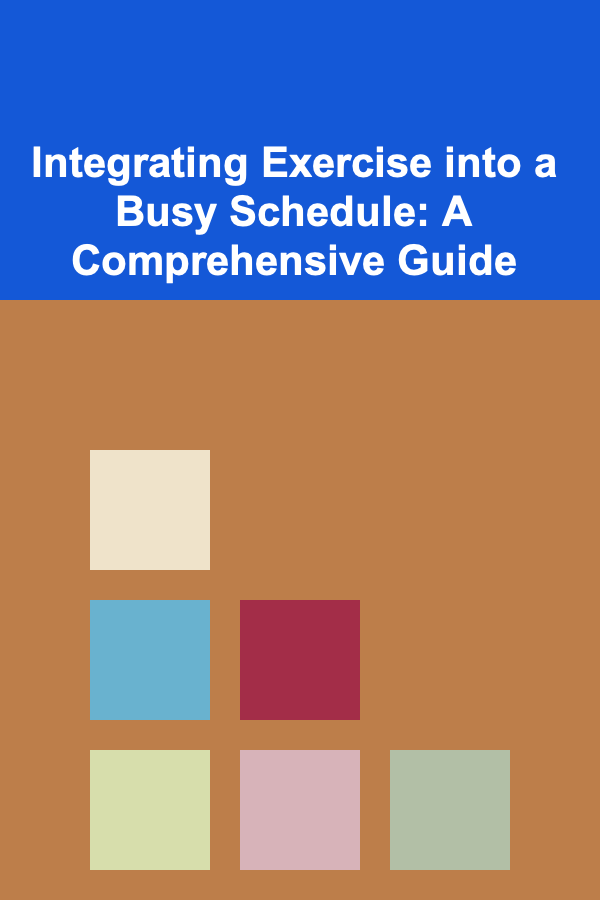
Integrating Exercise into a Busy Schedule: A Comprehensive Guide
ebook include PDF & Audio bundle (Micro Guide)
$12.99$6.99
Limited Time Offer! Order within the next:

In today's fast-paced world, squeezing exercise into an already packed schedule can feel like an insurmountable challenge. Demands from work, family, social obligations, and personal errands often leave little room for prioritizing physical activity. However, neglecting exercise can have significant consequences for both physical and mental well-being. The good news is that integrating exercise doesn't necessarily require hours at the gym. With strategic planning, creative thinking, and a commitment to making small, sustainable changes, even the busiest individuals can find ways to incorporate regular physical activity into their lives. This comprehensive guide provides practical strategies, actionable tips, and insightful perspectives to help you conquer the time crunch and reap the numerous benefits of exercise.
Understanding the Barriers: Why We Struggle to Exercise
Before delving into solutions, it's crucial to understand the common barriers that prevent people from exercising regularly. Recognizing these obstacles is the first step towards overcoming them:
- Lack of Time: This is the most frequently cited reason. People genuinely feel overwhelmed and believe they simply don't have enough time to dedicate to exercise.
- Lack of Motivation: Even with good intentions, maintaining motivation can be difficult, especially when faced with competing priorities.
- Lack of Energy: Feeling tired or exhausted after a long day can make the idea of exercising seem unappealing.
- Lack of Access: This includes factors like the cost of gym memberships, lack of nearby facilities, or limited access to safe outdoor spaces.
- Lack of Confidence: Some individuals feel self-conscious or intimidated by the idea of exercising in public, particularly if they are new to exercise or have concerns about their fitness level.
- Lack of Social Support: Without encouragement and support from friends, family, or colleagues, it can be challenging to stay committed to an exercise routine.
- Injury or Health Concerns: Pre-existing health conditions or past injuries can make exercise difficult or require modifications.
- Perfectionism: The belief that exercise must be intense and time-consuming can be discouraging, leading to procrastination or avoidance.
- Prioritization Issues: Exercise is often viewed as a luxury rather than a necessity, and is therefore easily pushed aside when other demands arise.
Shifting Your Mindset: Reframing Exercise as a Necessity
A fundamental shift in mindset is essential for integrating exercise into a busy schedule. Instead of viewing exercise as an optional activity, reframe it as a non-negotiable component of your overall health and well-being. Consider the long-term consequences of neglecting physical activity, such as increased risk of chronic diseases, decreased energy levels, and reduced quality of life. By prioritizing exercise, you are investing in your future health and productivity.
Here are some strategies for shifting your mindset:
- Focus on the Benefits: Regularly remind yourself of the numerous benefits of exercise, including improved mood, increased energy, reduced stress, better sleep, enhanced cognitive function, and reduced risk of chronic diseases.
- Set Realistic Expectations: Don't try to overhaul your entire lifestyle overnight. Start with small, manageable goals and gradually increase the intensity and duration of your workouts as you become more fit.
- Embrace Imperfection: It's okay to miss a workout occasionally. Don't let a slip-up derail your entire routine. Simply get back on track as soon as possible.
- Celebrate Small Victories: Acknowledge and celebrate your achievements, no matter how small. This will help you stay motivated and reinforce positive habits.
- Connect Exercise to Your Values: Link your exercise goals to your core values, such as health, well-being, or personal growth. This will make it easier to prioritize exercise when faced with competing demands.
Strategic Planning: Finding Time and Making it Count
Effective time management is crucial for integrating exercise into a busy schedule. This involves identifying pockets of time that can be dedicated to physical activity and making the most of those opportunities.
1. Time Auditing: Identify Where Your Time Goes
The first step is to conduct a time audit to determine how you currently spend your time. For one week, track all of your activities, including work, commuting, meals, leisure, and sleep. This will help you identify areas where you can potentially free up time for exercise.
2. Scheduling Exercise Like an Important Appointment
Treat exercise like any other important appointment in your schedule. Block out specific times for workouts and commit to those appointments as you would for a meeting with your boss or a doctor's appointment. Add these workouts to your calendar and set reminders.
3. Prioritizing and Saying "No"
Learn to prioritize your commitments and say "no" to activities that are not essential or that drain your energy. This may involve delegating tasks, setting boundaries, or simply declining invitations that don't align with your priorities.
4. Waking Up Earlier (or Exercising Later)
For many people, exercising first thing in the morning is the most effective way to ensure it gets done before the day gets away from them. However, if you're not a morning person, consider exercising during your lunch break or after work. Experiment with different times to find what works best for you.
5. Utilizing Commute Time
If possible, incorporate physical activity into your commute. Walk or bike to work, take the stairs instead of the elevator, or get off the bus or train a few stops early and walk the rest of the way.
6. Batching and Multitasking (Carefully)
Combine exercise with other activities whenever possible. For example, listen to podcasts or audiobooks while you walk or run, or watch your favorite TV show while you're on the treadmill or stationary bike. Be careful not to multitask in a way that compromises the quality of your workout or distracts you from your primary task.
7. Preparing in Advance
Reduce barriers to exercise by preparing in advance. Lay out your workout clothes the night before, pack your gym bag, and plan your meals and snacks ahead of time. This will make it easier to stick to your exercise routine even when you're feeling busy or tired.
8. Breaking Down Workouts into Smaller Chunks
If you don't have time for a long workout, break it down into smaller, more manageable chunks. A 10-minute walk in the morning, a 15-minute strength training session during your lunch break, and a 15-minute yoga routine in the evening can be just as effective as a longer workout.
Creative Exercise Strategies: Thinking Outside the Gym
You don't need a gym membership or expensive equipment to get a good workout. There are many creative ways to incorporate exercise into your daily life without disrupting your busy schedule.
1. Bodyweight Exercises: Your Own Personal Gym
Bodyweight exercises are a convenient and effective way to build strength and endurance without any equipment. Examples include push-ups, squats, lunges, planks, and burpees. You can do these exercises anywhere, anytime.
2. Active Breaks: Short Bursts of Activity Throughout the Day
Incorporate short bursts of activity throughout the day. Set a timer to remind you to get up and move every 30 minutes. Do a few jumping jacks, stretches, or walk around the office.
3. Walking Meetings: Combine Business with Movement
Instead of sitting in a conference room for your next meeting, suggest a walking meeting. This is a great way to get some exercise and fresh air while still being productive.
4. Family Activities: Make Exercise a Social Affair
Involve your family in your exercise routine. Go for a bike ride, hike, or play a game of basketball together. This is a fun way to spend quality time with your loved ones while getting some exercise.
5. Household Chores: Turn Responsibilities into Workouts
Turn household chores into opportunities for exercise. Gardening, mowing the lawn, raking leaves, and washing the car can all provide a good workout.
6. Dance Breaks: Unleash Your Inner Dancer
Put on your favorite music and dance for a few minutes each day. This is a fun and energizing way to get your heart rate up and relieve stress.
7. Using the Stairs: A Simple and Effective Workout
Take the stairs instead of the elevator or escalator whenever possible. This is a simple and effective way to burn calories and improve your cardiovascular fitness.
8. Online Workout Videos: Exercise from the Comfort of Your Home
Take advantage of the many free or affordable online workout videos available. You can find videos for a wide variety of exercises, including yoga, Pilates, strength training, and cardio.
The Importance of Finding Activities You Enjoy
The key to sticking with an exercise routine is to find activities that you genuinely enjoy. If you dread your workouts, you're less likely to stay motivated. Experiment with different types of exercise until you find something that you look forward to doing. Consider joining a sports team, taking a dance class, or exploring the outdoors.
Factors to consider when choosing an activity:
- Your Personality: Are you an introvert or an extrovert? Do you prefer solo activities or group activities?
- Your Interests: What do you enjoy doing in your free time? Can you incorporate physical activity into your hobbies?
- Your Fitness Level: Start with activities that are appropriate for your current fitness level and gradually increase the intensity as you become more fit.
- Your Access: What facilities and resources are available to you? Do you have access to a gym, swimming pool, or hiking trails?
- Your Budget: How much are you willing to spend on exercise? There are many free or low-cost options available.
Tracking Progress and Staying Motivated
Monitoring your progress can help you stay motivated and track your achievements. Use a fitness tracker, a journal, or a mobile app to record your workouts, track your steps, and monitor your progress towards your goals. Set realistic and achievable goals, and reward yourself for reaching milestones.
Here are some additional tips for staying motivated:
- Find an Exercise Buddy: Exercising with a friend or family member can provide accountability and support.
- Join a Fitness Community: Connect with other people who are passionate about fitness. Share your experiences, get advice, and find inspiration.
- Reward Yourself: Treat yourself to something you enjoy when you reach your fitness goals.
- Listen to Your Body: Don't push yourself too hard, especially when you're just starting out. Rest and recover when you need to.
- Be Patient: It takes time to see results. Don't get discouraged if you don't see progress immediately. Just keep showing up and putting in the effort.
Addressing Potential Setbacks
Even with the best planning, setbacks are inevitable. Illness, injury, travel, or unexpected events can disrupt your exercise routine. The key is to be flexible and adaptable. Don't let a setback derail your entire routine. Simply adjust your plans as needed and get back on track as soon as possible.
Here are some tips for dealing with setbacks:
- Don't Beat Yourself Up: It's okay to miss a workout. Don't let guilt or shame prevent you from getting back on track.
- Adjust Your Goals: If you're unable to exercise at your usual intensity or duration, modify your goals to something more manageable.
- Focus on What You Can Do: Even if you can't do your regular workout, find ways to stay active. Go for a walk, do some stretching, or perform light exercises.
- Seek Professional Help: If you're injured or experiencing pain, consult a doctor or physical therapist.
- Re-evaluate Your Routine: Use setbacks as an opportunity to re-evaluate your routine and make adjustments as needed.
The Long-Term Benefits of Consistent Exercise
While the initial motivation for integrating exercise might be weight loss or improved physical appearance, the long-term benefits extend far beyond aesthetics. Consistent exercise plays a crucial role in preventing chronic diseases, improving mental health, and enhancing overall quality of life.
Some of the long-term benefits include:
- Reduced Risk of Chronic Diseases: Exercise helps prevent heart disease, stroke, type 2 diabetes, some types of cancer, and osteoporosis.
- Improved Mental Health: Exercise can reduce symptoms of anxiety and depression, improve mood, and boost self-esteem.
- Increased Energy Levels: Regular exercise can combat fatigue and increase energy levels throughout the day.
- Better Sleep Quality: Exercise can improve sleep quality and reduce the risk of insomnia.
- Enhanced Cognitive Function: Exercise can improve memory, concentration, and cognitive function.
- Stronger Bones and Muscles: Exercise helps build and maintain strong bones and muscles, reducing the risk of falls and injuries.
- Increased Longevity: Studies have shown that people who exercise regularly tend to live longer and healthier lives.
By making exercise a consistent part of your life, you are investing in your long-term health and well-being.
Conclusion: Making Exercise a Sustainable Habit
Integrating exercise into a busy schedule is a challenge, but it's a challenge that can be overcome with strategic planning, creative thinking, and a commitment to making sustainable changes. By understanding the barriers to exercise, shifting your mindset, finding activities you enjoy, and tracking your progress, you can make exercise a consistent and enjoyable part of your life. Remember that even small amounts of exercise can have significant benefits. Start with small, manageable goals and gradually increase the intensity and duration of your workouts as you become more fit. Be patient, persistent, and celebrate your achievements along the way. The rewards of a healthy and active lifestyle are well worth the effort.
Ultimately, the key to long-term success lies in finding a balance between your busy schedule and your commitment to your health. Embrace the journey, be kind to yourself, and remember that every step counts.

How to Handle Negative Reviews and Protect Your Reputation on Airbnb
Read More
How to Sell Digital Planners for Students: An Actionable Guide
Read More
How to Sell Digital Products Successfully for Course Creators
Read More
How to Stage Your Home to Sell Faster in a Competitive Market
Read More
How to Stage Your Home to Sell in a Competitive Market
Read More
Top Ways to Profit from Deep Learning Projects
Read MoreOther Products

How to Handle Negative Reviews and Protect Your Reputation on Airbnb
Read More
How to Sell Digital Planners for Students: An Actionable Guide
Read More
How to Sell Digital Products Successfully for Course Creators
Read More
How to Stage Your Home to Sell Faster in a Competitive Market
Read More
How to Stage Your Home to Sell in a Competitive Market
Read More